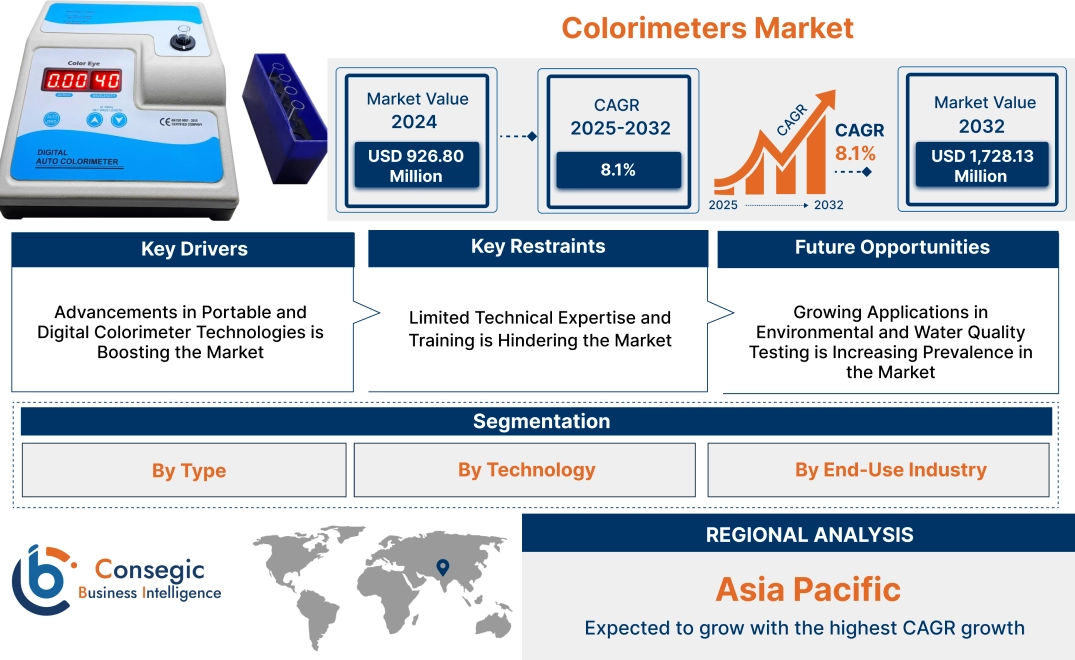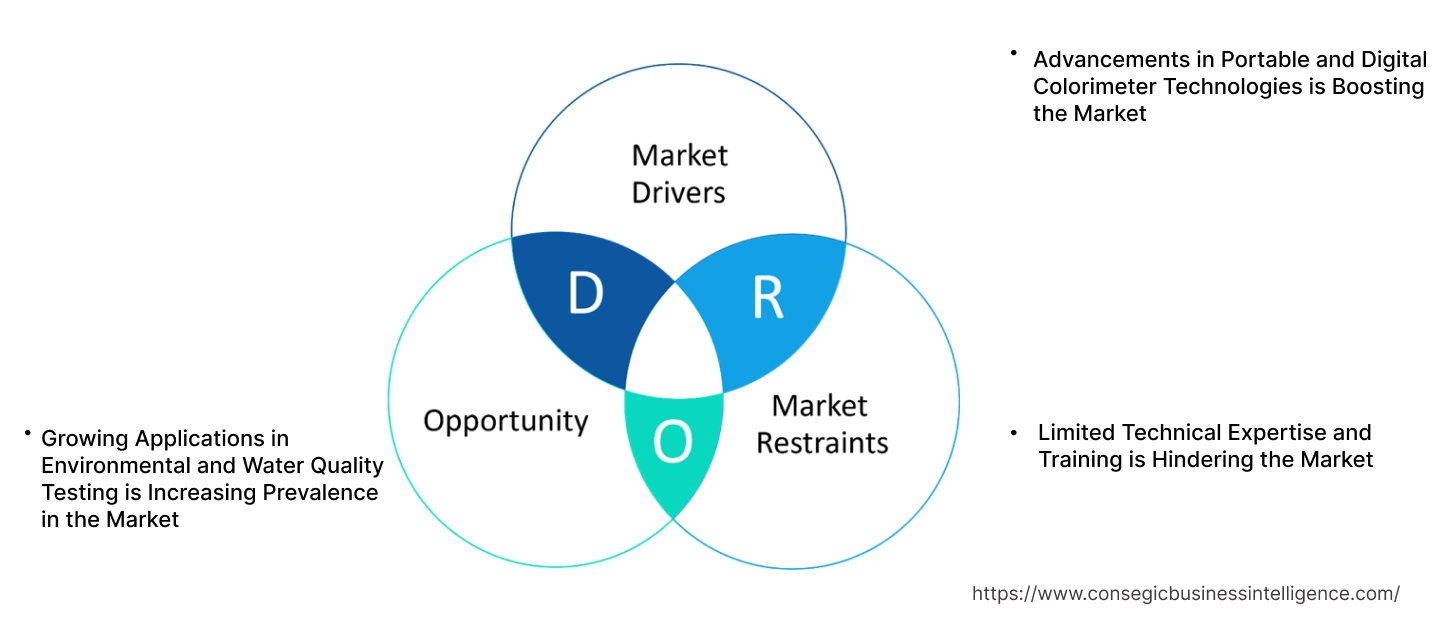- Summary
- Table Of Content
- Methodology
Colorimeters Market Size:
Colorimeters Market size is estimated to reach over USD 1,728.13 Million by 2032 from a value of USD 926.80 Million in 2024 and is projected to grow by USD 985.36 Million in 2025, growing at a CAGR of 8.1% from 2025 to 2032.
Colorimeters Market Scope & Overview:
The colorimeters are devices designed to measure the absorbance and concentration of color in solutions or materials. These instruments are widely used across pharmaceuticals, food and beverages, environmental testing, and chemicals for quality control, analysis, and compliance with standards. Key characteristics of colorimeters include high accuracy, compact designs, and user-friendly interfaces, allowing for precise color measurement and quantification of analytes.
The benefits include enhanced product consistency, improved efficiency in quality assurance processes, and reduced errors in color-based study. Applications span environmental monitoring (e.g., water quality testing), laboratory research, clinical diagnostics, and industrial quality control. End-users include environmental testing labs, pharmaceutical companies, food and beverage manufacturers, and academic institutions, driven by increasing demand for accurate analytical tools, stringent regulatory requirements for quality assurance, and advancements in portable and digital colorimeter technologies.
Key Drivers:
Advancements in Portable and Digital Colorimeter Technologies is Boosting the Market
Innovations in portable and digital colorimeters have significantly enhanced their functionality and user experience. Modern devices now feature compact designs, improved sensor accuracy, and wireless connectivity, allowing seamless integration with digital platforms for real-time data transfer and analysis. These advancements make colorimeters versatile tools across various industries, from quality control in manufacturing to environmental testing.
Trends in mobile application compatibility and cloud-based data storage further streamline operations, enabling users to track, store, and analyze results efficiently. The study highlights that these advancements not only improve operational efficiency but also make colorimeters more accessible for on-site and field applications.
Key Restraints:
Limited Technical Expertise and Training is Hindering the Market
Despite the technological advancements, the effective use of colorimeters requires specialized training and technical expertise. Many industries, particularly in emerging markets, lack adequately trained personnel to operate advanced devices and interpret their data accurately. This knowledge gap can result in underutilization or incorrect application, affecting the reliability of results.
Efforts to address this challenge include the development of user-friendly devices and industry training programs. However, a widespread lack of awareness about the importance of precise color measurement continues to be a barrier, particularly in small and medium-sized enterprises.
Future Opportunities :
Growing Applications in Environmental and Water Quality Testing is Increasing Prevalence in the Market
The rising emphasis on environmental sustainability and water quality monitoring presents significant opportunities for the colorimeter market. These devices are essential for measuring parameters such as chemical concentrations, turbidity, and contamination levels in water, aiding compliance with environmental regulations and standards.
Trends in green initiatives and sustainable resource management are driving the adoption of colorimeters in industries such as wastewater treatment, agriculture, and public health. The study indicates that the increasing focus on preserving natural resources and meeting regulatory requirements will continue to expand the application of colorimeters in environmental monitoring, creating new growth avenues for market players.
Colorimeters Market Segmental Analysis :
By Type:
Based on type, the market is segmented into portable colorimeters and benchtop colorimeters.
The portable colorimeters segment accounted for the largest revenue in colorimeters market share in 2024.
- Portable colorimeters are widely preferred for their compact design, ease of use, and ability to perform on-site color measurement across various industries.
- Their portability makes them ideal for environmental monitoring and field applications, driving their market dominance.
- Increasing adoption in quality control processes across sectors such as food & beverage and textiles is boosting colorimeters market trends.
- Technological advancements, including Bluetooth-enabled devices and integration with mobile apps, have further enhanced their usability and colorimeters market demand.
The benchtop colorimeters segment is anticipated to register the fastest CAGR during the forecast period.
- Benchtop colorimeters are highly accurate and reliable, making them a preferred choice for laboratory and industrial applications.
- Rising adoption in the pharmaceutical and chemical industries for precise color analysis is driving colorimeters market growth in this segment.
- Development of multifunctional benchtop colorimeters with advanced features, such as spectrophotometric capabilities, is boosting market expansion.
- Increased investment in research and development by industries requiring stringent quality standards is expected to propel trends.
By Technology:
Based on technology, the market is segmented into visual colorimeters and digital colorimeters.
The digital colorimeters segment accounted for the largest revenue in colorimeters market share in 2024.
- Digital colorimeters are widely used due to their high precision, rapid results, and ability to eliminate subjective errors associated with visual colorimeters.
- The increasing opportunities for automation and digital tools in laboratory and industrial processes is driving this segment's dominance.
- Integration of advanced digital technologies, such as AI and machine learning, in colorimeters for enhanced analysis and reporting is boosting colorimeters market opportunities.
- Growing adoption of digital devices in sectors such as pharmaceuticals, food & beverage, and chemicals is further supporting segment trends.
The visual colorimeters segment is anticipated to register the fastest CAGR during the forecast period.
- Visual colorimeters remain in demand for cost-effective applications in smaller industries and research labs where precise digital tools may not be necessary.
- Rising awareness about affordable and simple color measurement tools for basic quality control applications is driving growth in this segment.
- Technological improvements in visual colorimeters, such as improved calibration techniques and user-friendly designs, are expanding their application scope.
- Increased adoption in education and training settings for basic color analysis applications is expected to support colorimeters market trends.
By End-Use Industry:
Based on the end-use industry, the market is segmented into food & beverage, pharmaceuticals, textiles, chemicals, consumer goods, and others.
The food & beverage segment accounted for the largest revenue share of 29.80% in 2024.
- Colorimeters are extensively used in the food & beverage industry to ensure product consistency, quality control, and regulatory compliance.
- Increasing consumer colorimeters market demand for visually appealing food products has driven the need for precise color measurement.
- Stringent food safety and quality regulations require manufacturers to monitor color consistency throughout production.
- Technological advancements in portable and automated colorimeters have enhanced real-time quality checks in food processing facilities.
The pharmaceuticals segment is anticipated to register the fastest CAGR during the forecast period.
- The pharmaceutical industry relies on colorimeters for quality control in drug formulation, tablet coating, and packaging.
- Rising trends for high-quality and safe pharmaceutical products has increased the adoption of color measurement devices.
- Colorimeters are used to ensure the uniformity of color in tablets, capsules, and liquid formulations, meeting regulatory standards.
- Ongoing advancements in pharmaceutical manufacturing processes and increasing R&D investments are expected to propel market growth.
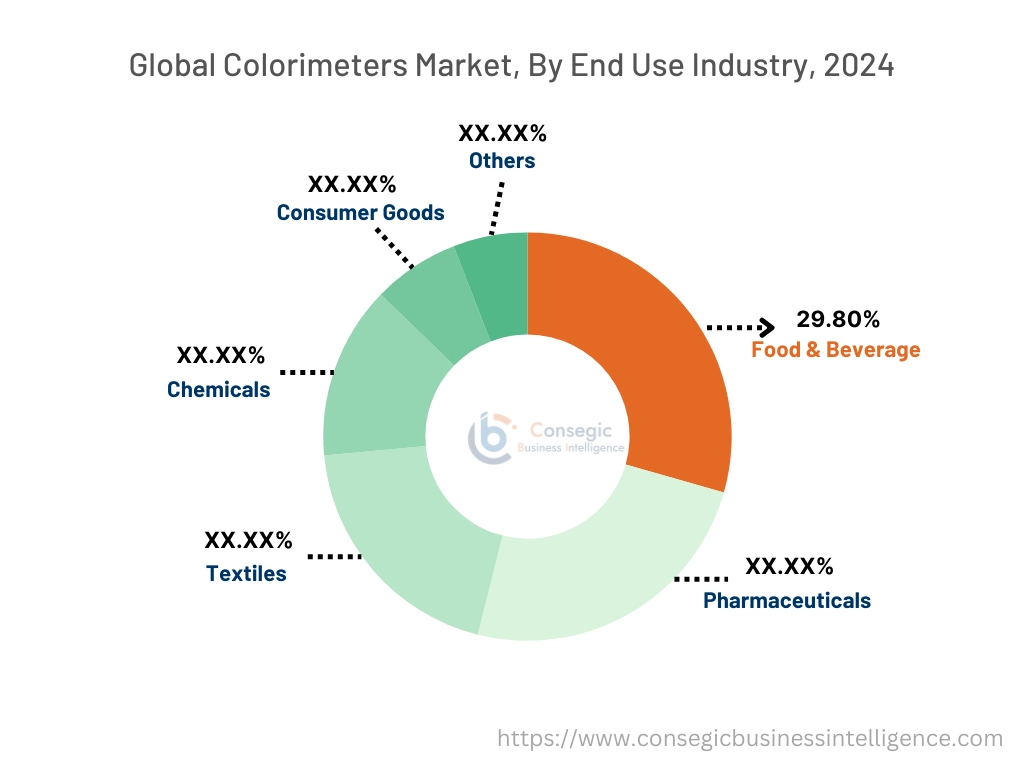
Regional Analysis:
The regions covered are North America, Europe, Asia Pacific, the Middle East and Africa, and Latin America.
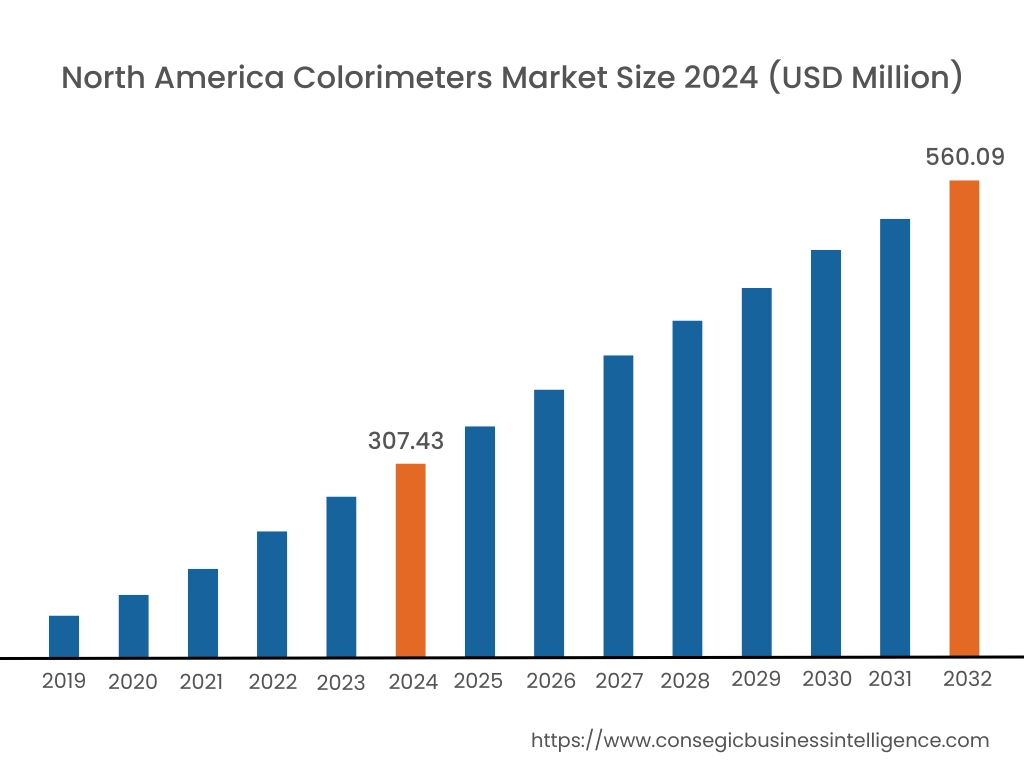
In 2024, North America was valued at USD 307.43 Million and is expected to reach USD 560.09 Million in 2032. In North America, the U.S. accounted for the highest share of 72.40% during the base year of 2024. North America holds a significant share in the global colorimeters market, driven by advancements in industries such as food & beverage, pharmaceuticals, and environmental testing. The U.S. leads the region due to widespread adoption of colorimeters in quality control processes, including water testing, chemical analysis, and food color measurement. The rising focus on environmental monitoring and stringent regulatory standards further support the demand for colorimeters. Canada contributes through growing usage in water treatment plants and research laboratories. However, the high cost of advanced colorimeter models may limit adoption in small-scale industries.
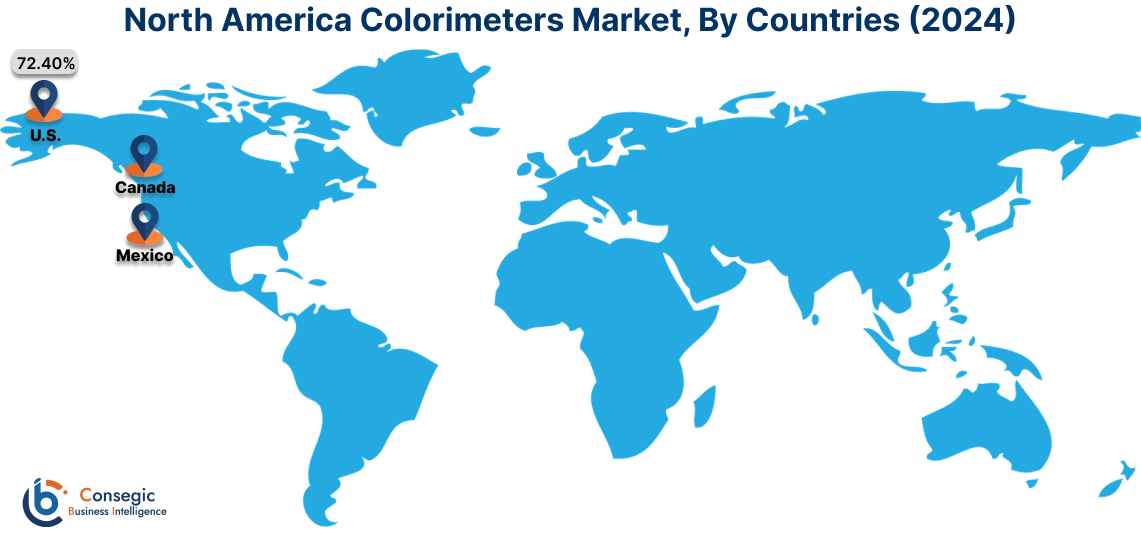
In Asia Pacific, the market is experiencing the fastest growth with a CAGR of 8.6% over the forecast period. The colorimeters market analysis, is fueled by rapid industrialization, expanding food & beverage industries, and increasing focus on water quality testing in China, India, and Japan. China dominates the market with rising adoption of colorimeters in manufacturing, environmental testing, and water treatment facilities. India’s growing demand is driven by increasing food safety regulations and the need for reliable water quality monitoring. Japan focuses on high-precision colorimeters in industries such as electronics, pharmaceuticals, and cosmetics, leveraging its strong technological advancements. However, affordability challenges and limited awareness in rural areas may hinder colorimeters market growth in certain parts of the region.
Europe is a prominent market for colorimeters, supported by strict environmental regulations, advanced manufacturing industries, and increasing investments in research and development. Countries like Germany, the UK, and France are key contributors. Germany drives trends through its robust industrial base, focusing on color measurement in automotive, chemical, and food industries. As per the colorimeters market analysis, the UK emphasizes the use of colorimeters in environmental monitoring and pharmaceutical quality control, while France adopts these devices for applications in cosmetics and textiles. However, the high cost of compliance with EU regulations may challenge smaller businesses in the region.
The Middle East & Africa region is witnessing steady growth in the global colorimeters market, driven by increasing demand for water quality testing and industrial applications. Countries like Saudi Arabia and the UAE are adopting colorimeters in water treatment plants, oil & gas industries, and environmental monitoring to meet regulatory requirements. In Africa, South Africa is an emerging market, leveraging colorimeters in agricultural research, water testing, and food production processes. However, limited local manufacturing capabilities and reliance on imports may restrict broader market expansion in the region.
Latin America is an emerging market for colorimeters, with Brazil and Mexico leading the region. Brazil’s expanding food & beverage and agricultural sectors drive demand for colorimeters in quality control and testing. Mexico focuses on environmental monitoring and water treatment applications, supported by government initiatives to improve water quality standards. The region is also exploring the use of colorimeters in textile and cosmetics industries. However, inconsistent regulatory frameworks and economic instability in smaller economies may pose challenges to colorimeters market expansion.
Top Key Players and Market Share Insights:
The colorimeters market is highly competitive with major players providing products to the national and international markets. Key players are adopting several strategies in research and development (R&D), product innovation, and end-user launches to hold a strong position in the colorimeters market. Key players in the colorimeters industry include -
- Konica Minolta, Inc. (Japan)
- Thermo Fisher Scientific Inc. (United States)
- Lovibond (United Kingdom)
- Metrohm AG (Switzerland)
- PCE Instruments (Germany)
- X-Rite, Incorporated (United States)
- Hanna Instruments, Inc. (United States)
- LaMotte Company (United States)
- Hach Company (United States)
- The Tintometer Ltd. (United Kingdom)
Colorimeters Market Report Insights :
| Report Attributes | Report Details |
| Study Timeline | 2019-2032 |
| Market Size in 2032 | USD 1,728.13 Million |
| CAGR (2025-2032) | 8.1% |
| By Type |
|
| By Technology |
|
| By End-Use Industry |
|
| By Region |
|
| Key Players |
|
| North America | U.S. Canada Mexico |
| Europe | U.K. Germany France Spain Italy Russia Benelux Rest of Europe |
| APAC | China South Korea Japan India Australia ASEAN Rest of Asia-Pacific |
| Middle East and Africa | GCC Turkey South Africa Rest of MEA |
| LATAM | Brazil Argentina Chile Rest of LATAM |
| Report Coverage |
|
Key Questions Answered in the Report
What is the projected size of the Colorimeters Market by 2032? +
Colorimeters Market size is estimated to reach over USD 1,728.13 Million by 2032 from a value of USD 926.80 Million in 2024 and is projected to grow by USD 985.36 Million in 2025, growing at a CAGR of 8.1% from 2025 to 2032.
What drives the growth of the colorimeters market? +
Growth is driven by advancements in portable and digital technologies, increasing applications in environmental and water quality testing, stringent regulatory requirements for quality assurance, and rising demand for precision in analytical tools.
What challenges does the market face? +
Challenges include a lack of technical expertise and training among operators, particularly in emerging markets, and high costs associated with advanced colorimeter models, limiting their adoption in small-scale industries.
Which segment dominates the market by type? +
Portable colorimeters hold the largest market share, favored for their compact design and suitability for on-site and field applications.
